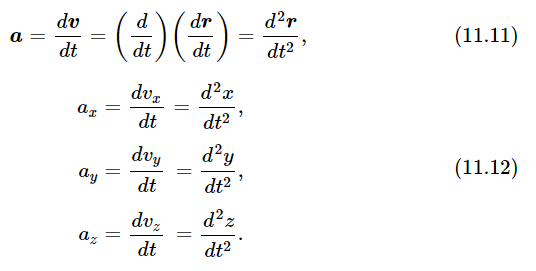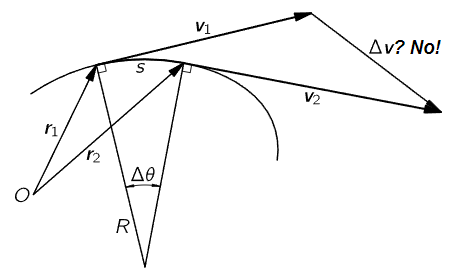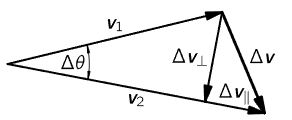
Newton’s laws in vector notation
 المؤلف:
Richard Feynman, Robert Leighton and Matthew Sands
المؤلف:
Richard Feynman, Robert Leighton and Matthew Sands
 المصدر:
The Feynman Lectures on Physics
المصدر:
The Feynman Lectures on Physics
 الجزء والصفحة:
Volume I, Chapter 11
الجزء والصفحة:
Volume I, Chapter 11
 2024-02-11
2024-02-11
 1739
1739
In order to write Newton’s laws in vector form, we have to go just one step further, and define the acceleration vector. This is the time derivative of the velocity vector, and it is easy to demonstrate that its components are the second derivatives of x, y, and z with respect to t:

With this definition, then, Newton’s laws can be written in this way:

Now the problem of proving the invariance of Newton’s laws under rotation of coordinates is this: prove that a is a vector; this we have just done. Prove that F is a vector; we suppose it is. So if force is a vector, then, since we know acceleration is a vector, Eq. (11.13) will look the same in any coordinate system. Writing it in a form which does not explicitly contain x’s, y’s, and z’s has the advantage that from now on we need not write three laws every time we write Newton’s equations or other laws of physics. We write what looks like one law, but really, of course, it is the three laws for any particular set of axes, because any vector equation involves the statement that each of the components is equal.

Fig. 11–7. A curved trajectory.

Fig. 11–8. Diagram for calculating the acceleration.
The fact that the acceleration is the rate of change of the vector velocity helps us to calculate the acceleration in some rather complicated circumstances. Suppose, for instance, that a particle is moving on some complicated curve (Fig. 11–7) and that, at a given instant t1, it had a certain velocity v1, but that when we go to another instant t2 a little later, it has a different velocity v2. What is the acceleration? Answer: Acceleration is the difference in the velocity divided by the small-time interval, so we need the difference of the two velocities. How do we get the difference of the velocities? To subtract two vectors, we put the vector across the ends of v2 and v1; that is, we draw Δv as the difference of the two vectors, right? No! That only works when the tails of the vectors are in the same place! It has no meaning if we move the vector somewhere else and then draw a line across, so watch out! We have to draw a new diagram to subtract the vectors. In Fig. 11–8, v1 and v2 are both drawn parallel and equal to their counterparts in Fig. 11–7, and now we can discuss the acceleration. Of course, the acceleration is simply Δv/Δt. It is interesting to note that we can compose the velocity difference out of two parts; we can think of acceleration as having two components, Δv∥, in the direction tangent to the path and Δv⊥ at right angles to the path, as indicated in Fig. 11–8. The acceleration tangent to the path is, of course, just the change in the length of the vector, i.e., the change in the speed v:

The other component of acceleration, at right angles to the curve, is easy to calculate, using Figs. 11–7 and 11–8. In the short time Δt let the change in angle between v1 and v2 be the small angle Δθ. If the magnitude of the velocity is called v, then of course
Δv⊥ = vΔθ
and the acceleration a will be
a⊥ = v(Δθ/Δt).
Now we need to know Δθ/Δt, which can be found this way: If, at the given moment, the curve is approximated as a circle of a certain radius R, then in a time Δt the distance s is, of course, vΔt, where v is the speed.

 الاكثر قراءة في الميكانيك
الاكثر قراءة في الميكانيك
 اخر الاخبار
اخر الاخبار
اخبار العتبة العباسية المقدسة


